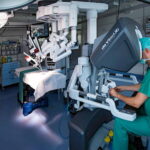Lung cancer
Disease description
Lung cancer is one of the most common and life-threatening oncological diseases. It originates from lung tissue cells and often metastasizes to other organs. Statistically, this type of cancer occurs 7—8 times more frequently in men than in women. The primary risk factor is smoking, but the disease can also be caused by exposure to asbestos, radon, and other carcinogens (particularly relevant for workers in asbestos and metal product manufacturing industries).
According to the World Health Organization, the incidence of lung cancer has increased dozens of times since the early 20th century. This trend is especially evident in developed countries, where lung cancer currently ranks among the leading causes of oncological mortality.
Symptoms requiring diagnosis and treatment
- Persistent cough that does not stop
- Hemoptysis (coughing up blood)
- Shortness of breath and wheezing
- Chest pain that worsens with coughing or deep breathing
- Unexplained weight loss and loss of appetite
- Fatigue and weakness
Diagnostic and treatment methods
Diagnosis
Lung cancer diagnosis involves several key methods. Computed tomography (CT) provides detailed imaging of lung tissue, helping to detect tumors. Positron emission tomography (PET scan) assesses the metabolic activity of the tumor and identifies metastases. Bronchoscopy allows for direct visualization of the airways and tissue sampling for biopsy, and transthoracic biopsy under CT or ultrasound guidance helps collect the tissue samples from hard-to-reach areas of the lung.
Treatment
The treatment approach depends on the cancer type, stage, and the patient’s overall condition. Surgical removal of the tumor, including lobectomy or pneumonectomy, is commonly performed in early stages. Chemotherapy is used to destroy cancer cells and can be used before or after surgery. Radiotherapy helps shrink tumors and eliminate remaining cancer cells. Targeted therapy and immunotherapy, which have been actively developed in recent years, focus on specific molecular targets in cancer cells. These approaches improve treatment outcomes and enhance survival rates.
Innovations in global clinics
Among the latest advancements in oncology treatment are targeted therapy and immunotherapy. Targeted therapy works by inhibiting specific genetic mutations in cancer cells, blocking their growth. Immunotherapy boosts the immune system’s ability to fight cancer by using medications that enhance immune responses.
These methods, combined with modern diagnostic technologies such as liquid biopsy and molecular tumor profiling, enable the development of personalized treatment plans that significantly improve therapy effectiveness and patient prognosis.
Top clinics
-
 Baden-Baden, Germany Max Grundig Clinic
Baden-Baden, Germany Max Grundig Clinic -
 Istanbul, Turkey Acibadem Altunizade
Istanbul, Turkey Acibadem Altunizade -
 Istanbul, Turkey Medistate International Hospital
Istanbul, Turkey Medistate International Hospital -
 Istanbul, Turkey Acıbadem Ataşehir Clinic
Istanbul, Turkey Acıbadem Ataşehir Clinic -
 Antalya, Turkey Hospital Medical Park Antalya
Antalya, Turkey Hospital Medical Park Antalya -
 Dubai, UAE NMC Healthcare
Dubai, UAE NMC Healthcare -
 Istanbul, Turkey Hospital “Memorial Şişli”
Istanbul, Turkey Hospital “Memorial Şişli” -
 Milan, Italy San Donato Hospital in Milan, Italy
Milan, Italy San Donato Hospital in Milan, Italy -
 Milan, Italy San Raffaele University Hospital
Milan, Italy San Raffaele University Hospital -
 Abu Dhabi, UAE Burjeel Hospital Abu Dhabi
Abu Dhabi, UAE Burjeel Hospital Abu Dhabi -
 Vienna, Austria Debling Private Clinic
Vienna, Austria Debling Private Clinic -
 Vienna, Austria Confraternität Private Hospital
Vienna, Austria Confraternität Private Hospital -
 Heidelberg, Germany Heidelberg University Hospital
Heidelberg, Germany Heidelberg University Hospital -
 Hamburg, Germany Asklepios Nord Heidberg
Hamburg, Germany Asklepios Nord Heidberg -
 Dusseldorf, Germany FKKD Clinical Complex
Dusseldorf, Germany FKKD Clinical Complex -
 Incheon, South Korea Gil Medical Center at Gachon University
Incheon, South Korea Gil Medical Center at Gachon University -
 Lausanne, Switzerland Clinique Montchoisy
Lausanne, Switzerland Clinique Montchoisy -
 Nyon, Switzerland Clinique Genolier
Nyon, Switzerland Clinique Genolier -
 Istanbul, Turkey “Memorial Ataşehir” Clinic
Istanbul, Turkey “Memorial Ataşehir” Clinic -
 Bodrum, Turkey Acibadem Bodrum Hospital
Bodrum, Turkey Acibadem Bodrum Hospital -
 Barcelona, Spain QuironSalud Barcelona Hospital
Barcelona, Spain QuironSalud Barcelona Hospital -
 Barcelona, Spain Medical Center "Teknon"
Barcelona, Spain Medical Center "Teknon" -
 Barcelona, Spain Sant Joan de Deu Children's Hospital
Barcelona, Spain Sant Joan de Deu Children's Hospital -
 Barcelona, Spain University Hospital Barnaclinic+
Barcelona, Spain University Hospital Barnaclinic+ -
 Madrid, Spain University Hospital HM Monteprincipe
Madrid, Spain University Hospital HM Monteprincipe -
 Hamburg, Germany Asklepios Klinik Barmbek
Hamburg, Germany Asklepios Klinik Barmbek -
 Gebze, Turkey Anadolu Clinic
Gebze, Turkey Anadolu Clinic -
 Zurich, Switzerland Hirslanden Clinic
Zurich, Switzerland Hirslanden Clinic -
 Madrid, Spain Quiron Salud University Hospital
Madrid, Spain Quiron Salud University Hospital -
 Lugano, Switzerland Saint Anna Clinic
Lugano, Switzerland Saint Anna Clinic -
 Geneva, Switzerland Clinique des Grangettes
Geneva, Switzerland Clinique des Grangettes -
 Duesseldorf, Germany Oncological Center Dusseldorf
Duesseldorf, Germany Oncological Center Dusseldorf -
 Seoul, South Korea Samsung Medical Center
Seoul, South Korea Samsung Medical Center -
 Seoul, South Korea Medical Center at Ewha Womans University
Seoul, South Korea Medical Center at Ewha Womans University -
 SNUH
SNUH -
 Seoul, South Korea Asan Medical Center
Seoul, South Korea Asan Medical Center -
 Jerusalem, Israel Hadassah Medical Center
Jerusalem, Israel Hadassah Medical Center -
 Petah Tikva, Israel Medical Center “Rabin”
Petah Tikva, Israel Medical Center “Rabin” -
 Istanbul, Turkey Medipol Mega University Hospital
Istanbul, Turkey Medipol Mega University Hospital -
 Istanbul, Turkey Istanbul Florence Nightingale Hospital
Istanbul, Turkey Istanbul Florence Nightingale Hospital -
 Geneva, Switzerland Hirslanden Clinique La Colline
Geneva, Switzerland Hirslanden Clinique La Colline -
 Geneva, Switzerland Generale-Beaulieu
Geneva, Switzerland Generale-Beaulieu -
 Vienna, Austria Private clinic "Rudolfinerhaus"
Vienna, Austria Private clinic "Rudolfinerhaus" -
 Dubai, UAE American Hospital Dubai
Dubai, UAE American Hospital Dubai -
 Freiburg, Germany University Hospital of Freiburg
Freiburg, Germany University Hospital of Freiburg -
 Berlin, Germany Charité Clinic
Berlin, Germany Charité Clinic -
 Munich, Germany University Hospital of Munich (Ludwig-Maximilians-Universität)
Munich, Germany University Hospital of Munich (Ludwig-Maximilians-Universität) -
 Vienna, Austria Wiener Privatklinik (WPK)
Vienna, Austria Wiener Privatklinik (WPK) -
 Zurich, Switzerland Bethanien Clinic
Zurich, Switzerland Bethanien Clinic


















































